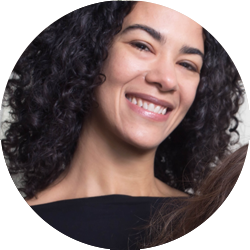The scene: We’re at the playground, having a ball. My toddler screeches with joy at meeting another 2-year-old. She holds his hand as they take big steps up the stairs to the slide, the picture of cuteness. She waits at the top of the slide for her new friend to sit down, too, so they can slide down together. They do this over and over and over again. She discards her shoes on the grass and abandons her sweater on the bench: getting serious now. But it’s time to go. How to avoid a scene by putting it just so?
Or: She has figured out how to pull her stool from its slot between the fridge and the wall, unfold it, place it just so, hoist herself up onto the kitchen counter, and get some dried peaches from the upper cabinet. (Let’s ignore, for this post, the acrobatics.) As soon as I say, “No more peaches,” I see a tantrum brewing across her face. How to head it off and still get those peaches back?
Or: It’s bedtime, and my husband has just finished reading a story with her in bed. She’s picked, of course, the longest book she owns. (He still has enough patience at the end of the day to read every page, whereas I know exactly which parts to skip so the story still makes sense. In my version, the Cat in Hat falls on his head, the fish in the pot says what a mess … hey, here comes the Cat to clean it all up!) He closes the book. Her usual response: “Again!” A straight-up “No, it’s bedtime” would bring those storm clouds tumbling across her face — just as it’s time to float peacefully into sweet dreams.
Every day, multiple times a day, one phrase saves the day: “One more, and then ____.”
“One more dried peach, and then please put the bag back in the cabinet. Those are a treat; we just eat a couple at a time.”
“One more time down the slide, and then we’ll put on your shoes and go home. Grandma is meeting us at home soon.”
“One more story, and then I’m going to turn out the light, kiss you goodnight, and close the door. It’s time for sleeping.”
Why does this little phrase work as often as it does at age 2? A few reasons.
It sets clear expectations for what will happen next. It provides us with an opening to calmly set a boundary, in a neutral tone. And most of all, it defuses a power struggle by acknowledging what our child wants. Toddlers, like all of us, seek control over their lives. You can imagine how you would feel if someone grabbed your favorite snack from your hands and said, “OK, that’s enough.”
“One more time” means both of us get what we want.
If my daughter still struggles to comply, I lightly remind her: “I said one more time, and we did one more time.” I turn on some enthusiasm, even if I’m low on patience and have to fake it: “That was so much fun, wasn’t it? We can do that again another time. Now we’re going to ____.”
The trick here is to swiftly move to do that next thing, rather than let my intentions dissipate by just kind of standing around–or rendering my word meaningless by agreeing to another “one more time.”
But more often than not, I need to say it only one time.
Have a favorite phrase that saves your day? Add it in the comments below.
Written by
Tracy Cutchlow
Tracy is the author of the international bestseller Zero to Five: 70 Essential Parenting Tips Based on Science, a public speaker, and a creator of places to speak and be heard. Sign up for her newsletter here.


I flippppinnnnngggg love!!!! that phrase. And I mean flipping like so happy it makes you jump up and down. I love the fact that everyone wins and gets what they want. I love how it is considerate, compassionate and helps children to form a bridge to learning self control and regulation and that although they can’t do what they want for ever, they do get that “one more time and then _______. This technique definitely gains more cooperation and teaches children that there is a time and place and reason for everything but in a child friendly way. It’s great for the adults too! I use this phrase all the time with my students, especially the boys. I teach children from infancy to 5 and use Creative Movement and Dance as a tool to help them develop cognitively, physically and socio-emotionally. I usually say one more time and then it’s time to _______________. Thanks so much for the reminder and I love how it’s used in so many scenarios. 🙂
I’m jumping up and down over your enthusiasm! 😀 Thanks so much for taking the time to share your big heart!
I only wish it worked that well with my just turned 3 year old. But I will continue to use it consistently. Eventually he’ll learn that, with mum, that’s exactly what it means. I’ve been using it for a long time now, and he knows exactly what it means, sometimes I just wonder if he will be a debater when he grows up. Hahaha
Ha! Yes, it’s such a bummer when something that used to work doesn’t anymore. 🙂 Age 3 is the peak of defiance….